Fostoria Shade and Lamp Company
The Fostoria Shade and Lamp Company was the largest manufacturer of glass lamps in the United States during the early 1890s. It began operations in Fostoria, Ohio, on May 17, 1890. The plant was run by Nicholas Kopp Jr., a former chemist at Hobbs, Brockunier and Company in West Virginia. Kopp achieved fame for his many glass designs and formulas for various colors of glass, and he is the discoverer of the American formula for selenium-based ruby glass. The company's products were very popular, and it was able to make significant profits early in its existence. In addition to lamps and shades for home lighting, the company also made novelties such as salt shakers.
| Type | Private company |
|---|---|
| Industry | Glassware |
| Founded | 1890 |
| Founder | W. C. Brown, James B. Graham |
| Defunct | 1893 |
| Successor | Consolidated Lamp and Glass Company |
| Headquarters | Fostoria, Ohio, U.S. |
Key people | Nicholas Kopp Jr. |
| Products |
|
Number of employees | 250 (December 1893) |
In 1893 the company faced difficulties with its fuel supply for its glassmaking furnaces. In addition, the nationwide depression known as the Panic of 1893 began in January, and company president and politician Charles Foster filed for personal bankruptcy. The company merged with the Pittsburgh-based company Wallace & McAfee later in 1893, and the combined company was called Consolidated Lamp and Glass Company. Operations continued at the Fostoria glass works after it was officially taken over by the new company on January 1, 1894. Difficulty with the natural gas supply caused Consolidated Lamp and Glass Company to construct a new plant near Pittsburgh. The Fostoria plant was mostly shut down by December 1895, and the new Pennsylvania glass works began operations on March 16, 1896. Consolidated Lamp and Glass operated until 1964.
Background
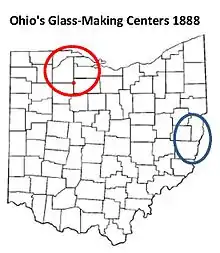
Glass is made by starting with a batch of ingredients, melting it, forming the glass product, and gradually cooling it. The batch of ingredients is dominated by sand, which contains silica.[1] Other ingredients such as soda ash, potash, and lime are added.[2] The batch is placed inside a pot or tank that is heated by a furnace to roughly 3090 °F (1700 °C).[1] In the glass–making industry, the melted batch is called "metal".[3] The metal is typically shaped into the glass product (other than window glass) by either a glassblower or pressing it into a mold.[4] The glass product must then be cooled gradually (annealed), or else it will become brittle and possibly break.[5] An oven used for annealing is called a lehr.[6] Because most glass plants melted their ingredients in a pot during the 1880s, the plant's number of pots was often used to describe a plant's capacity.[Note 1] One of the major expenses for the glass factories is fuel for the furnace.[8] Wood and coal had long been used as fuel for glassmaking. An alternative fuel, natural gas, became a desirable fuel for making glass because it is clean, gives a uniform heat, is easier to control, and melts the batch of ingredients faster.[9]
In the 1870s, Ohio had a glass industry located principally in the eastern portion of the state, especially in coal-rich Belmont County. The Belmont County community of Bellaire, located on the Ohio side of the Ohio River across from Wheeling, West Virginia, was known as "Glass City" from 1870 to 1885.[10] In early 1886, a major discovery of natural gas (the Karg Well) occurred in northwest Ohio near the small village of Findlay.[11] Communities in northwestern Ohio began using low-cost natural gas along with free land and cash to entice glass companies to start operations in their towns.[12] Their efforts were successful, and at least 70 glass factories existed in northwest Ohio between 1886 and the early 20th century.[13] The city of Fostoria, already blessed with multiple railroad lines, was close enough to the natural gas that it was able to use a pipeline to make natural gas available to businesses.[14] Eventually, Fostoria had 13 different glass companies at various times between 1887 and 1920.[15][Note 2] The gas boom in northwestern Ohio enabled the state to improve its national ranking as a manufacturer of glass (based on value of product) from 4th in 1880 to 2nd in 1890.[18]
Lamps in the 1890s

During 1859, petroleum was discovered in Pennsylvania.[19] This discovery, plus the increased usage of coal oil from Kentucky, led to increased demand for kerosene lamps and lanterns. During the 1860s, the major glass factory in West Virginia could not produce enough lamps to meet demand.[20] Kerosine lamps were used in the home for lighting, since electric lighting was only beginning in the late 1800s.[21] By 1907, electricity still reached only eight percent of the homes in the United States, and the percentage did not reach 35 until 1920.[22] Lamps from 1890s consisted of a stand, font, chimney, and often a shade.[23] The font (also spelled "fount") held the kerosine for the lamp.[24] The chimney was a glass tube placed around the lamp's flame that had a bulge at the base that kept drafts away from the flame and added extra illumination.[25] A lamp's shade was a glass object that surrounded the light source and diffused it.[26]
Fostoria Shade and Lamp years
Beginning
On November 9, 1889, Fostoria's Buttler Art Glass Company lost its glass works to a fire that was described as "most disastrous that ever occurred in Fostoria".[27] The plant employed about 180 people, and it was only partially insured.[28] A major problem for the glass works was that the site did not have a good connection to city water, making it difficult for firefighters to fight fires.[29] Among the major Buttler stockholders were James B. Graham and Colonel Wilbur C. Brown, who were from Pittsburgh and Fostoria, respectively. Another Fostoria investor was the former governor of Ohio, Charles Foster.[30] In January 1890 the shareholders of Buttler Art Glass decided that it would be too costly to rebuild.[31]
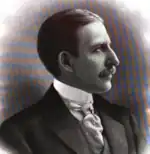
On February 6, Colonel Brown made public a plan that if he could get enough funding, he would start a bigger and better glass works.[32] Less than a week later, Brown announced that he, Graham, and other Buttler Art Glass investors would build a factory to manufacture colored shades, lamps, and novelties.[33] A second announcement said that the new glass works would be managed by someone with "a reputation for making fine colored ware second to no man in the glass trade".[34][Note 3] The plant superintendent was later identified as Nicholas (Nick) Kopp Jr, who had been working as the chemist at Hobbs Glass Company in Wheeling, West Virginia.[37][Note 4] One historian notes that Kopp's father was already working in Fostoria at the Fostoria Glass Company, and Charles Foster was on that firm's board of directors in addition to being involved with the new Fostoria Lamp and Shade Company.[41]
The Buttler Art Glass lot (and debris) was offered for sale on February 20. Eventually, the ruined factory site was sold to another group of investors (including Foster) that formed the Novelty Glass Company.[42][Note 5] Despite the news releases about the new glass works, the Fostoria Shade and Lamp Company was not formally organized until after it was announced that Kopp was hired. Brown and Graham's new company was formally organized in early March and named Fostoria Shade and Lamp Company.[33] Among members of the board of directors were Graham and Brown. Foster became president, and William S. Brady was vice president.[44][Note 6] Brady had held leadership positions at J. H. Hobbs, Brockunier and Company, Riverside Glass Company, and temporarily held leadership positions at both Fostoria Glass Company and Fostoria Shade and Lamp Company.[46] Graham was secretary–treasurer.[44]
Operations
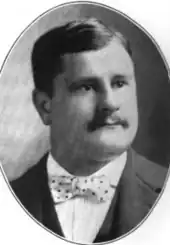
The new factory was located in the Hancock County section of Fostoria near the tracks of the Nickel Plate Railroad. The plan was to have one 10-pot furnace, two lehrs, and small ovens for decorating and molds. Fuel would be natural gas.[47][Note 7] The factory was completed close to the projected date, and production started on May 17, 1890.[49] By August, one journal reported that the company's beautiful pressed lamps were selling "like hot cakes".[50][Note 8] A year later in 1891, the plant was reported to have 250 workers and working three shifts per day.[50] Kopp was born in Alsace–Lorraine, and could speak German and French along with English.[52] Many of Fostoria's skilled glassworkers were from Austria, Belgium, and France.[53] Local lore, unproven, is that Kopp divided his factory's three shifts into German–speaking, French–speaking, and English–speaking groups.[52]
By the summer of 1892, a report in a trade journal mentioned the company's wide variety of colors, shapes, sizes, and styles for lamps—and was also complementary of the lamp shades.[54][Note 9] The Fostoria Shade and Lamp company was the largest manufacturer of lamp shades in the United States.[56] In November, concern over a tariff caused jobbers to pause buying glassware, forcing manufacturers to put employees on half time so the company would not be overloaded with unsold products.[56]
Unusual patterns
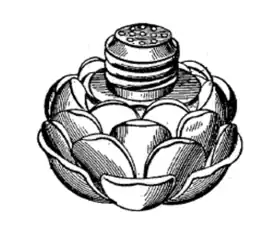
As the largest lamp producer in the United States, and with a plant run by a famous chemist, Fostoria Shade and Lamp Company had numerous colorful products that were very popular.[57] Among products made that were not lamps or shades were salt and pepper shakers. Kopp received a patent on March 10, 1891, for a salt shaker design that looked like a rose. The patent calls the design "Closed Vessel with Perforated Cover", and Kopp applied for the patent on January 24, 1891.[58] A publication released in 1998 valued a rare pair of these rose shakers, with a holder, at $710 to $730 (equivalent to $1,293 in 2022) for the set.[59]
In 1892, Fostoria Shade and Lamp produced a lamp shaped like Santa Claus. The May 25, 1892, edition of Crockery & Glass Journal mentioned strong demand for the company's night lamps, and mentioned a new Santa Claus lamp that is "neat and novel".[60] Then in the November 3, 1892 edition of the same journal the company's novelties were described as having strong demand, and the Santa Claus lamp was an "emphatic hit".[61] The same journal again mentioned the Santa Claus lamp in its November 17, 1892, edition, where it described the night lamp for the holidays as one that "ought surely to prove attractive to buyers".[62] Originally, this lamp sold for $4 (equivalent to $130 in 2022) per dozen. By 1988, collectors were willing to pay a four figure amount for one.[63]
Depression
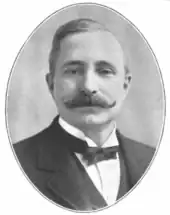
An economic depression began in January 1893 and became known as the Panic of 1893, bringing deflation and a high unemployment to the nation.[64] Fostoria Shade and Lamp Company had done well enough in 1892 that it declared a cash dividend in the spring of 1893. Charles Foster completed his term as United States Secretary of the Treasury, and was re-elected president of Fostoria Shade and Lamp Company.[61][Note 10] In May the nation was shocked when Foster declared bankruptcy.[66] Three window glass companies that Foster had invested in (Mambourg Glass Company, Crocker Glass Company, and Calcine Glass Company) shut down and some banks and non-glass companies were also affected.[67]
Fostoria Shade and Lamp Company was a successful internationally known style leader for glass lamps, yet it had the bankruptcies in Fostoria that were perhaps scaring creditors.[68] The company caught the attention of businessmen Frank G. Wallace and Hugh W. McAfee. These men owned Wallace & McAfee, Limited, which was a glassware distributor in Pittsburgh. In November, they began negotiations to purchase Fostoria Shade and Lamp Company, which they would merge with their firm to form a new company called Consolidated Lamp and Glass Company. The new company would be headquartered in Pittsburgh, with Wallace as president and Graham (from Fostoria Lamp and Glass) secretary.[69] The sale of the largest manufacturer of lamps and shades in the United States was official on December 13, 1893.[70][Note 11]
Consolidated Lamp and Glass Company
.png.webp)
The Fostoria Shade and Lamp glass works had 250 employees in December 1893. Consolidated Lamp and Glass Company officially took possession of the Fostoria glass works on January 1, 1894. Production would continue in Fostoria, while warehouses would be in Pittsburgh.[69] According to a notice in a Pittsburgh newspaper, Wallace & McAfee Company, Limited, was not officially dissolved until June 25, 1894.[71]
The new company made few management changes at its Fostoria glass works when it started in January 1894. Charles Foster resigned as president, and James Graham (the former secretary) became secretary of the parent company and general manager of the Fostoria works. Nicholas Kopp remained plant superintendent.[72] Improvements and expansions were made at the Fostoria plant, and the facility continued to produce products in numerous colors. The company was said to be the only firm casing glass with a layer of crystal. It was operating day and night.[73][Note 12] During 1894, Nicholas Kopp discovered a formula for making ruby (deep red) glass using selenium instead of gold.[75] The new formula replaced the older formula that used gold, and the growing automobile industry increased demand for ruby glass.[75] At least one source considers this one of the notable developments in the American glass industry.[76]
Fuel problems
Graham and Kopp had already been having problems receiving enough natural gas to power the factory's furnaces. The plant had to shut down for two weeks at the end of March and beginning of April because of the fuel problem.[77] In June, the Fostoria plant was described as receiving large orders and working day and night.[78][Note 13] Frank Wallace, president of Consolidated Lamps and Glass, visited the Fostoria facility during the summer break. He decided to run the factory using oil instead of natural gas. The oil system was installed immediately and a one-year contract was signed with Standard Oil Company. Fostoria's natural gas, when available, would be used only for the lehrs.[79] Among advertisements made in the fall was one for the Santa Claus Night Lamp—now a product of the Consolidated Lamp and Glass Company.[80][Note 14]
In May 1895 Graham informed the local natural gas board that the company's contract with Standard Oil would expire in September, and the oil company would not renew it. He warned that if the company could not secure gas or oil for its furnaces, it would be forced to move to a location near a coal supply. For a short time, the threat had positive results and more gas became available.[79] A new source of oil also became available. In late May it was announced that the plant's fuel supply problem was solved by a new contract with Sun Oil Company.[81] In June the glass works was said to be operating three shifts and producing approximately 150 different styles and decorations. The company claimed it was making more lamps than all of the other glass works in the United States combined.[74][Note 15]
Move to Pennsylvania
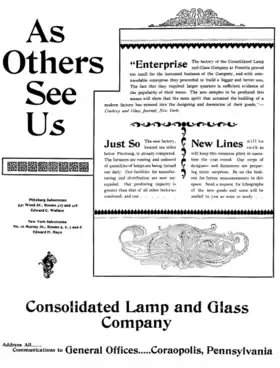
During the summer, gas became scarce again and the company switched to oil.[82] An October 8, 1895, newspaper article announced that the Consolidated Lamp and Glass Company would move its glass works from Fostoria to Coraopolis, Pennsylvania. The company was offered seven acres (2.8 ha) of free land, and a bonus, to build their factory there. The location is close to Pittsburgh, and the new factory was expected to employ about 300 workers.[83] Later in the month it was announced that construction of the glass Factory would start in a few weeks, and the plant would cover five acres (2.0 ha). The factory was expected to be operating by January 1. The new plant would have a capacity of four tanks and three furnaces, which was the equivalent of 46 pots.[84] Tank furnaces were essentially large brick pot furnaces with multiple workstations.[85] About 400 workers were expected to be employed.[84]
The Fostoria plant was shut down near the end of December, causing over 200 men to lose their jobs.[86] Equipment was moved to the new Coraopolis facility, and about 40 Fostoria workers moved to Corapolis to work at the new plant.[87] The new Coraopolis plant made a partial start in March 1896, and a full force started on the following week.[88] An advertisement by the company made it appear that the move from Fostoria to Corapolis was to expand capacity to meet growing demand—and did not mention Fostoria's fuel problems.[89] Nicholas Kopp eventually left the company and started the Kopp Lamp and Glass Company in 1900, with operations starting in 1901.[90] The Corapolis works of Consolidated Lamp and Glass Company operated until 1964.[91]
Notes
Footnotes
- The ceramic pots were located inside the furnace. The pot contained molten glass created by melting a batch of ingredients that typically included sand, soda, lime, and other ingredients.[7]
- The count of Fostoria glass companies varies depending on how restarts and reorganizations are counted. The Fostoria Ohio Glass Association lists 13 companies for 1887–1920.[16] Paquette discusses 15 companies plus four post-boom companies in Chapter V of his Blowpipes book.[17]
- Paquette cited a Fostoria Review newspaper article dated February 13, 1890, for the announcement of the "second to no man" plant manager.[35] Murray cites the same quote from the February 20, 1890, edition of the Crockery & Glass Journal.[36]
- The J.H. Hobbs, Brockunier and Company was reorganized multiple times over a period of about 50 years. It began as Barnes, Hobbs and Company in 1845. It was later named Hobbs, Barnes, and Company and also Hobbs and Barnes. After Barnes retired in 1863, the company was reorganized as J.H. Hobbs, Brockunier and Company.[38] This version lasted until 1881, when John L. Hobbs died and the company reorganized as Hobbs, Brockunier and Company.[39] A new version of the company, a corporation instead of a partnership, was organized in 1888 as the Hobbs Glass Company.[40]
- The water issue would become a problem again in 1893 for the owners of the Novelty Glass Company when their facility, built on the same site as the Buttler Art Glass Company works, was destroyed by fire.[43]
- Murray cites the organization of Fostoria Shade and Lamp Company from the May 13, 1890, edition of the Crockery & Glass Journal.[45]
- The 1890 Annual Report of the Geological Survey of Ohio agreed that the fuel for the new company was natural gas, but listed the furnace as 16 pots.[48]
- Murray cites the August 21, 1890, edition of the National Glass Budget for the August lamp sales information.[50] Paquette agrees with the "hot cakes" quote, writing that it can be found on page 2 of National Glass Budget.[51]
- Paquette cites the July 27, 1892, edition of China, Glass & Lamps for the description of lamps and shades.[55]
- Although Murray says Foster was re-elected, a newspaper claimed that James B. Graham was president of the company in November 1892.[65]
- Murray cites the December 13, 1893, edition of China, Glass & Lamps for the sale and factory size information.[70]
- Murray cites a February 28, 1894, article titled "New Home of the Consolidated Lamp and Glass Company in China, Glass & Lamps as the source for his information on the early 1894 operations.[74]
- Murray cites a June 13, 1894, article from China, Glass & Lamps as the source for his information on the June 1894 operations in Fostoria.[74]
- Murray shows the Santa Claus lamp advertisement on page 152 of his book. The advertisement is said to come from the September 25, 1894 edition of China, Glass & Lamps.[80]
- Murray cites a June 19, 1895, article from China, Glass & Lamps as the source for his information on the June 1895 operations in Fostoria.[74]
Citations
- "How Glass is Made – What is glass made of? The wonders of glass all come down to melting sand". Corning. Archived from the original on July 5, 2023. Retrieved July 5, 2023.
- Skrabec 2007, p. 25
- Shotwell 2002, p. 343
- Weeks & United States Census Office 1884, p. 45
- "Corning Museum of Glass – Annealing Glass". Corning Museum of Glass. Archived from the original on July 5, 2023. Retrieved July 5, 2023.
- "Corning Museum of Glass – Lehr". Corning Museum of Glass. Archived from the original on July 5, 2023. Retrieved July 5, 2023.
- Skrabec 2007, pp. 25–26
- United States Department of Commerce, Bureau of Foreign and Domestic Commerce 1917, p. 12
- United States Department of Commerce, Bureau of Foreign and Domestic Commerce 1917, p. 36
- McKelvey 1903, p. 170
- Paquette 2002, pp. 24–25
- Paquette 2002, p. 26
- Paquette 2002, p. 28
- H. Sabine, Commissioner of Rail Roads & Telegraphs (1882). New Rail Road Map of Ohio prepared by H. Sabine, Commissioner of Rail Roads & Telegraphs (Map). Wapakoneta, Ohio: R. Sutton (Library of Congress). Archived from the original on March 27, 2023. Retrieved August 5, 2023.; Paquette 2002, p. 173; Geological Survey of Ohio 1890, p. 190
- "Fostoria Ohio Glass Association". Fostoria Ohio Glass Association. Archived from the original on March 28, 2023. Retrieved March 27, 2023.
- "Fostoria Ohio Glass Association". Fostoria Ohio Glass Association. Archived from the original on August 10, 2022. Retrieved March 27, 2023.
- Paquette 2002, pp. 170–229
- United States Census Office 1895, p. 315
- "First Oil Discoveries". American Oil & Gas Historical Society. Archived from the original on July 10, 2023. Retrieved July 10, 2023.
- Newton, Nichols & Sprankle 1879, p. 239
- "History of the Kerosene Lamp". Iowa State University – University Museums. Archived from the original on August 21, 2023. Retrieved August 21, 2023.
- Woolf, Arthur G. (April 1987). "The Residential Adoption of Electricity in Early Twentieth-Century America". The Energy Journal. Woodmere, Ohio: International Association for Energy Economics. 8 (2): 19–30 JSTOR. JSTOR 41322257. Archived from the original on August 21, 2023. Retrieved August 21, 2023.
- Shotwell 2002, pp. 290–291
- Shotwell 2002, p. 189
- Shotwell 2002, p. 85
- Shotwell 2002, p. 494
- Paquette 2002, p. 187
- Paquette 2002, pp. 186–187
- Murray 1992, p. 133
- Paquette 2002, p. 184
- Paquette 2002, p. 188
- Paquette 2002, pp. 201–202
- Paquette 2002, p. 202
- Paquette 2002, p. 202; Murray 1992, pp. 133–134
- Paquette 2002, pp. 202, 498
- Murray 1992, pp. 133–134
- Paquette 2002, p. 202; Bredehoft & Bredehoft 1997, p. 30
- Baker 1986, p. 108
- "The Glass Houses (columns on left side of p.9)". Wheeling Daily Intelligencer (from Chronicling America: Historic American Newspapers. Lib. of Congress). September 14, 1886. Archived from the original on July 14, 2023. Retrieved July 14, 2023.
- Bredehoft & Bredehoft 1997, p. 21
- Murray 1992, p. 135; Paquette 2002, p. 180
- Murray 1992, p. 133; Murray 1992, p. 33; Paquette 2002, p. 205
- Paquette 2002, p. 217
- Paquette 2002, p. 202; Murray 1992, pp. 136–137
- Murray 1992, pp. 136–137
- Bredehoft & Bredehoft 1997, p. 28; Paquette 2002, p. 248
- Paquette 2002, pp. 202–203
- Geological Survey of Ohio 1890, p. 191
- Paquette 2002, p. 203
- Murray 1992, p. 138
- Paquette 2002, pp. 203, 498
- Murray 1992, p. 139
- Weiser & Findlay-Hancock County Chamber of Commerce (Ohio) 2007, p. 33
- Paquette 2002, pp. 203–204
- Paquette 2002, pp. 203–204, 498
- "On Half Time (page 1 near bottom)". Providence News (from Chronicling America: Historic American Newspapers. Lib. of Congress). November 14, 1892. Archived from the original on August 17, 2023. Retrieved August 17, 2023.
- "On Half Time (page 1 near bottom)". Providence News (from Chronicling America: Historic American Newspapers. Lib. of Congress). November 14, 1892. Archived from the original on 2023-08-17. Retrieved 2023-08-17.; Bredehoft & Bredehoft 1997, p. 30; Paquette 2002, p. 203
- United States Patent 20,566, Nicholas Kopp, "Design for a Closed Vessel with Perforated Cover", issued March 10, 1891 Archived August 24, 2023, at the Wayback Machine
- Lechner & Lechner 1998, p. 158
- Murray 1992, pp. 139–140
- Murray 1992, p. 140
- "Santa Claus (D)". Early American Pattern Glass Society. Archived from the original on August 21, 2023. Retrieved August 21, 2023.
- Gold (Chicago Tribune), Anita (December 15, 1988). "Yuletide Collections Are Traditional". Daily Record (Morristown, New Jersey). p. 22.
...today one in good condition will command a four-figure sum.
- "The Depression of 1893". Economic History Association. Archived from the original on March 19, 2017. Retrieved July 10, 2023.
- "People Coming and Going (page 2 near bottom)". Pittsburgh Dispatch (from Chronicling America: Historic American Newspapers. Lib. of Congress). January 25, 1892. Archived from the original on 2023-08-17. Retrieved 2023-08-17.
- "Failure of Charles Foster (page 1 top center)". Indianapolis Journal (from Chronicling America: Historic American Newspapers. Lib. of Congress). May 27, 1893. Archived from the original on 2023-08-22. Retrieved 2023-08-22.
- "Failure of Charles Foster (page 1 top center)". Indianapolis Journal (from Chronicling America: Historic American Newspapers. Lib. of Congress). May 27, 1893. Archived from the original on 2023-08-22. Retrieved 2023-08-22.; Paquette 2002, pp. 178, 193, 200–201
- Paquette 2002, p. 204; Murray 1992, p. 141
- "Fostoria Lamp Factory Sold". Wooster Daily Republican. December 15, 1893. p. 1.
...which is already employing 250 people.
; Paquette 2002, p. 204; Murray 1992, pp. 144–145 - Murray 1992, p. 145
- "Notice (middle of second column from right)". Pittsburgh Post-Gazette. June 30, 1894. p. 3.
Wallace & McAfee Company, Limited...been dissolved....
- Paquette 2002, pp. 218–219
- Murray 1992, pp. 145, 148–149
- Murray 1992, p. 159
- Shively, R.R. (September 1924). "Principles of Glass Making – Use of Selenium in Glass". The Ceramist. Newark, New Jersey: Ceramics Publishing Company. 4 (6): 371–374. Retrieved August 25, 2023.
- Tillotson, E. Ward (December 1920). "Modern Glass-Making – Putting the Glass Industry on a Scientific Basis". Scientific American Monthly. New York City: Scientific American Publishing Company. II (4): 351–354. Retrieved August 25, 2023.
- Paquette 2002, p. 219
- Murray 1992, pp. 150–151
- Paquette 2002, p. 220
- Murray 1992, pp. 152–153
- "Untitled (2nd column from left)". Telegraph-Forum (Bucyrus, Ohio). May 31, 1895. p. 5.
The company was refused a renewal of their Fuel contract with the Standard people, but the Sun Oil Company has come to the rescue....
- Paquette 2002, p. 221
- "Coraopolis Gets a Glass Plant". Pittsburgh Press. October 8, 1895. p. 1.
The Consolidated Lamp & Glass company, of Fostoria, O., will move its big plant....
- "Untitled (left column 2/3 down)". Pittsburgh Press. October 20, 1895. p. 2.
Work will start in a few weeks....
- United States Department of Commerce, Bureau of Foreign and Domestic Commerce 1917, p. 61
- "Untitled (left column, one third down)". Lima Clipper. December 27, 1895. p. 2.
The Consolidated Lamp and Glass Co., has shut down their plant....
- Paquette 2002, p. 223
- "Untitled (5th column from left, near center)". Pittsburgh Press. March 28, 1896. p. 6.
The new glass plant...has made a partial start.
- "As Others See Us (advertisement)". Glass and Pottery World. Chicago, Illinois: American Glass and Pottery World Company. IV (4): 36. April 1896. Retrieved August 25, 2023.
- Murray 1992, p. 160; "Untitled (left column 2/3 down)". Pittsburgh Post. December 20, 1900. p. 10.
The Kopp Lamp and Glass Company, a new concern, is the buyer of the Autocar Company's plant....
; "Big Lamp Works For Swissvale". Pittsburgh Post. March 17, 1901. p. 11.The company expect[s] to have the plant in operation early in May.
- Paquette 2002, p. 224
References
- Baker, Gary E. (June 1986). The Flint Glass Industry in Wheeling, West Virginia: 1829–1865 (MA). University of Delaware. Archived from the original on 2023-07-12. Retrieved 2023-07-12.
- Bredehoft, Neila M.; Bredehoft, Thomas H. (1997). Hobbs, Brockunier and Co., Glass: Identification and Value Guide. Paducah, KY: Collector Books. ISBN 978-0-89145-780-0. OCLC 37340501.
- Geological Survey of Ohio (1890). Annual Report of the Geological Survey of Ohio. Columbus, Ohio: Westbote Co., State Printers. OCLC 13585464. Archived from the original on August 3, 2023. Retrieved August 4, 2023.
- Lechner, Mildred; Lechner, Ralph (1998). The World of Salt Shakers: Antique & Art Glass Value Guide Volume III. Paducah, Kentucky: Collector Books. ISBN 978-1-57432-065-7. OCLC 39502285.
- McKelvey, Alexander T. (1903). Centennial History of Belmont county, Ohio and Representative Citizens. Chicago: Biographical Publishing Company. OCLC 318390043.
Centennial history of belmont county.
- Murray, Melvin L. (1992). Fostoria, Ohio Glass II. Fostoria, OH: M. L. Murray. OCLC 27036061.
- Newton, J. H.; Nichols, G. G.; Sprankle, A. G. (1879). History of the Pan-handle: Being Historical Collections of the Counties of Ohio, Brooke, Marshall and Hancock, West Virginia. Wheeling, West Virginia: J.A. Caldwell. ISBN 978-1-55613-413-5. OCLC 12537018. Archived from the original on 2023-07-25. Retrieved 2023-06-28.
- Paquette, Jack K. (2002). Blowpipes, Northwest Ohio Glassmaking in the Gas Boom of the 1880s. Xlibris Corp. ISBN 1-4010-4790-4. OCLC 50932436.
- Shotwell, David J. (2002). Glass A to Z. Iola, Wisconsin: Krause Publications. ISBN 978-0-87349-385-7. OCLC 440702171.
- Skrabec, Quentin R. (2007). Michael Owens and the Glass Industry. Gretna, Louisiana: Pelican Publishing. OCLC 137341537.
- United States Census Office (1895). Report on manufacturing industries in the United States at the eleventh census: 1890. Washington: Government Printing Office. OCLC 10470409.
- United States Department of Commerce, Bureau of Foreign and Domestic Commerce (1917). The Glass Industry. Report on the Cost of Production of Glass in the United States. Washington: Government Printing Office. OCLC 5705310.
- Weeks, Joseph D.; United States Census Office (1884). Report on the Manufacture of Glass. Washington, District of Columbia: U.S. Government Printing Office. OCLC 2123984. Archived from the original on July 16, 2023. Retrieved June 26, 2023.
- Weiser, Paulette J.; Findlay-Hancock County Chamber of Commerce (Ohio) (2007). Historic Hancock County: An Illustrated History. San Antonio, Texas: Historical Publishing Network. OCLC 1391569311.
External links
- Fostoria Shade and Lamp Company page - Fostoria Ohio Glass Association
- Fostoria Shade and Lamp various patterns – Early American Pattern Glass Society